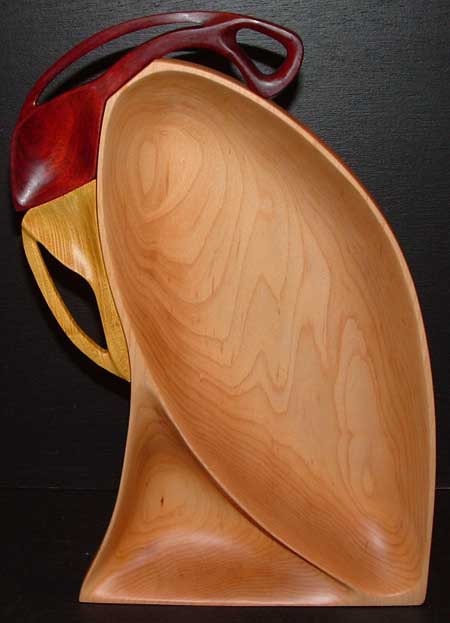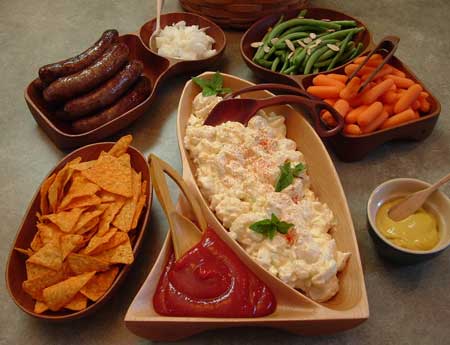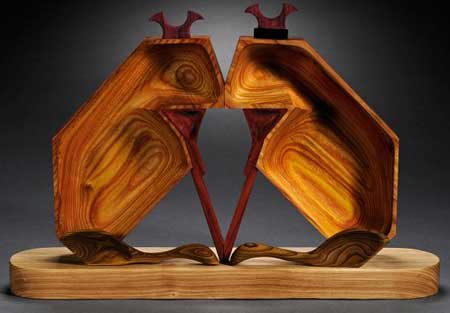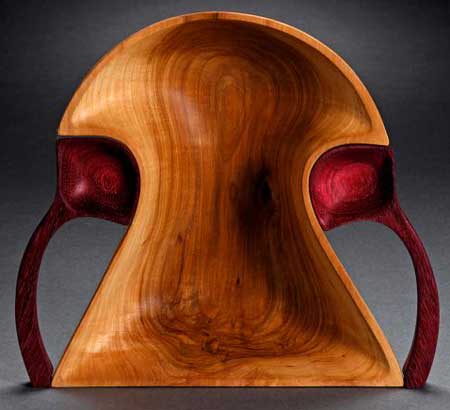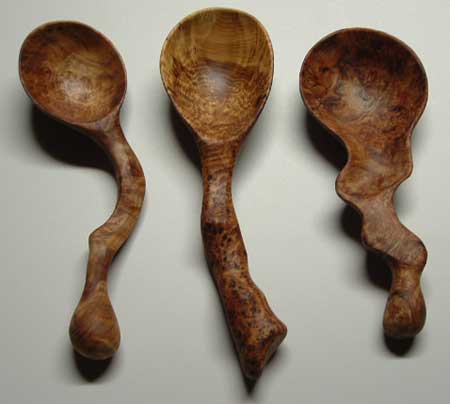
Paul Jensen has been around wood all his life: with a dad who was a carpenter and cabinetmaker, “Wood was my toy,” he said. “If I wanted to play blocks or something, I’d pick up wood and make something – maybe a little toy boat or put wheels on it and make a little toy truck.”
He’s also spent years as a furniture designer and builder and a maintenance supervisor for college, youth and retirement housing situations. But, since 2001, he’s been concentrating his Wisconsin business, P.J.’s Woods, on one particular niche of woodworking: culinary items. This includes spoons, “bowls, mixing tools, anything do with culinary, serving or preparing,” he said.
It’s a specialty that started when Paul’s wife came back from a home party with a catalog and wanted to order a wooden spoon. “I said, ‘I’ll make them for you,'” Paul said. “The next day I went out to the shop and spent eight hours figuring it out, seeing how something works.” He brought the first spoon in for that evening’s dinner hour – “and it broke right in half.
The next day, I went out to the shop and spent eight hours making two spoons, that I’m still using today.
My goal is to have one of my spoons or utensils in everybody’s kitchen, and be the favorite one they grab when they’re cooking.”
As part of that goal, Paul does extensive research on any new wood species he’s considering using in his work, due to the fact that some woods’ oils can be toxic. For example, he mentioned the Mexican wood chechen: “It’s from the same family as poison ivy, and persons sensitive to poison ivy would definitely not want a spoon made out of that wood.” Walnut must be dried before it can be used for cooking and serving bowls, and Paul limits cocobolo to accent use because of its oils.
Much of the wood in his pieces comes from readily accessible Midwestern species – hard and soft maple, cherry, walnut – but he’s also been known to use lilac (“Lilac makes an excellent spoon – if you can find a big enough piece,” Paul says); common roadside sumac, which creates a light green to yellow green spoon; and yellow birch. This last, Paul says, is “the best spoon wood”: it’s flexible, yet has the hard density that means it doesn’t stain when used with tomato-based products.
Paul’s also in the process of researching the possibilities of persimmon and Alaskan yellow cedar for culinary items.
As for making those items, even though Paul does make bowls and does own a lathe, he refers to that tool as the most expensive piece in his shop that serves as a storage area for his burls. Instead, he creates using different power carving tools to take away the wood he doesn’t want and create unlimited shapes: “arches, squares, triangles, and combinations thereof.”
Recently, he’s been interested in making sculptural pieces, that have both a functional use and can stand alone as an art object. For instance, it might be a spoon incorporated into a vessel that can stand alone in the living room. “It’s a spoon as an art piece that can be enjoyed anywhere in the house on display and then, when you want to use it, it won’t hurt it a bit.”
His “Reverse Fairy Tale” is an example of one of these sculptural pieces: two matching spoons form the front legs of two creatures sitting side-by-side; two more serving spoons made from common sumac form the back legs; the creatures themselves are bowls, and the tray they are sitting on flips over to make a bread tray.
In part because he does over half of the cooking in his own household, Paul says, in general, he enjoys designs that make things easier in the kitchen. For instance, he and his wife – the family baker – together created a long, curved tool for mixing and folding in items that scrapes the edge of a mixing bowl. “It was a fun project,” Paul said. “I took a bowl, cut it in half to get the tool needed to fit the curve, and then I modify it to fit other size bowls with the same general curve.
Making sauces led him to create the “spootula”: a spatula-shaped spoon that offers a lot of control over the bottom area of a saucepan, allowing you to quickly mix a lot of ingredients in over a high heat. And, since he has canned raspberry jelly and preserved maple syrup, he invented the scoop-and-pour – a spoon with a spout on its side that allow someone to transfer such things into another container “and not be a sticky mess,” Paul said.
His wife’s work as an occupational therapist has also influenced Paul’s building. For instance, “I’ve learned that a handle the size of a lemon is good for somebody with severe arthritis.” He’s made gripping tools that allow people to turn on an oven burner. And, when he’s building a spoon for a particular person, he’ll often use a piece of modeling clay for them to imprint their grip on. “That way, I can get a nice fit for the fingertips, the palm of the hand, everything, depending on the kind of grip they have.”
With the creation of all of his utensils and serving items, Paul said, “It’s very gratifying to know people are having fun cooking. With any job, if you have good tools, it’s always a more pleasant experience.”
As for his own job creating these items – each piece with the initials PJ carved into it, “so people know if’s an original, made by my two hands and not by anybody else” – Paul says there’s also another aspect that helps him enjoy it.
“I have a short attention span.” With a furniture design, it might take years to find the right wood, and two or three months to build the piece, Paul said. “With a spoon, I got something done today.”

